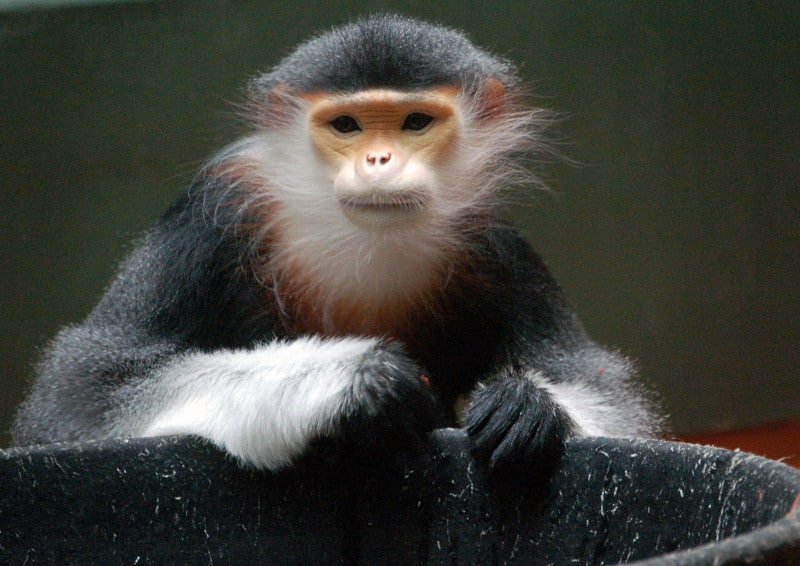
Red-shanked douc Facts
- The highly descriptive term of Red-shanked douc serves as the most frequently used common name for a most remarkable species of primate. It does have other general titles, though. These include the terms Costumed monkey, Five-colored macaque, and Red-legged douc.
- In scientific circles, however, this fabulous animal’s likely much better known by its technical designation. LIke most such monikers, though, that’s hard for the layperson to pronounce. That’s because the mammal holds the hard to pronounce name formal of Pygathrix nemaeus.
- But, regardless of which name one uses to refer to it, one fact stands out about the amazing creature. That statement has to do with its intriguing appearance. Quite understandably, many consider this marvel of Nature to be among the most colorful of all known primates.
- Due to the comparative remoteness of its native habitat, it’s only been studied in any detail in modern times. Astoundingly, before the year 1967 this magnificent creation of Nature remained completely unstudied. As a result, even now some details about it remain unknown.
- The limited information currently available about the beautiful Red-shanked douc, however, concerns many individuals. Due to the nature of that data, the IUCN lists it as Endangered. This unfortunate status appears on the organization’s Red List of Threatened Species.
- Lamentably, the known population of the species only totals approximately 1,300 individuals. Its limited native range also makes it vulnerable to habitat loss. Both these factors subsequently render it especially vulnerable to the threat posed by the ongoing effects of climate change.
Related Articles
Capuchin
Red-shanked douc Physical Description
The attention-grabbing Red-shanked douc generally does exactly that with those who see it for the first time, namely seizing their interest. The natural marvel usually does so, though, due to its highly distinctive appearance. In terms of sheer size, it’s a comparatively small example of its kind.
The remarkable creature shares many physical attributes with its related species. Among these stands the fact that it evolved a relatively long, slender body shape. Much like those same relatives, and indeed many species, it also displays a moderate degree of the trait of sexual dimorphism.
In its case, this evolutionary principle manifests itself in terms of pure physical size. As a result, the males of the fascinating creature attain a greater average body length than their female counterparts. However, the degree of mean difference in this regard actually generally equates to less than 10%.
Males reach an average head and body length measuring about 24 in (61 cm). The female, meanwhile, averages around 21.5 in (54.5 cm) in length. Among both genders, the tail usually adds an additional 22 – 30 in (56 – 76 cm). Males further average 24 lb (11 kg), and females 18.6 lb (8.4 kg).
Yet, the coloring of the animal itself easily represents the most distinctive characteristic of the Red-shanked douc. The back and stomach present a light gray color. But the lower legs show a deep red, while the feet and hands appear black. The upper legs and forearms display a white color.
The face, though, displays the most striking appearance. Its skin appears yellowish-orange, along with the ears. The eyelids, however, show a light powder-blue shade. The eyes also have an almond shape, and the nose grows very small. It even displays long white whiskers on the chin and cheeks.
- Kingdom: Animalia
- Phylum: Chordata
- Class: Mammalia
- Order: Primates
- Family: Cercopithecidae
- Genus: Pygathrix
- Species: P. nemaeus
Red-shanked douc Distribution, Habitat, and Ecology
Unfortunately, the astonishing Red-shanked douc evolved as indigenous to an extremely restricted section of the earths surface. Given its exotic nature, however, the setting for that likely won’t surprise many people. That’s due to the fact that the wonder of evolution’s native to Asia.
Within that greater overall region, though, it only lives in a very tiny portion of the area. That’s because it appears to only live in a very small section of the region known as Indochina. More precisely, the animal lives in scattered parts of the country of Vietnam and southern areas of Laos.
Pleasantly, however, this may not be its only area of habitation in. That’s due to an unsual, and currently unresolved situation. To the hopeful surprise of many, sightings of it occasionally occur in northeastern Cambodia, as well. For the moment, though, these reports still remain unconfirmed.
Within its given range, however, this remarkable primate seems to be relatively adaptable to differing habitats. That holds true since individuals appear in areas of both mountain and lowland areas. Sightings of the monkey also take place in primary, secondary, and partially deciduous forests.
But, in all areas it inhabits, certain preferences clearly predominate. The magnificent Red-shanked douc appears almost exclusively in either the middle or upper regions of the forest canopy. The beautiful mammal rarely descends to the ground, since it acquires its water through its food.
Like its many kin, the remarkable species of mammal evolved as a complete vegetarian. In its specific case, that diet mainly consists of various leaves high in fiber content. It does nonetheless occasionally consume smaller quantities of seeds, bamboo shoots, buds, flowers, and also fruit.
It additionally evolved a principally diurnal pattern of behavior. The primate spends the majority of its life in the canopy. There, and also like others of its kind, it lives as a strongly social animal. Groups typically number 4 -15 individuals. Groupings of as many as 50 have been seen, though.
Species Sharing Its Range
Check out our other articles on Earth’s Many Magnificent Marsupials, Black-and-white hawk-eagle, Salar de Uyuni, Chatham Island forget-me-not, Velvet Belly lanternshark, Rainbow Snake
